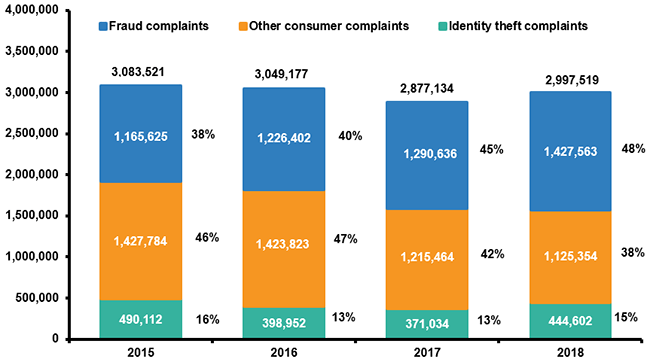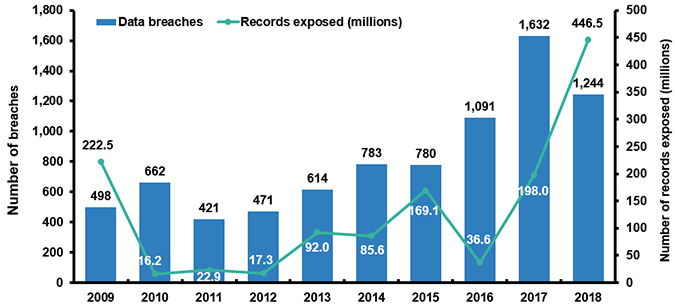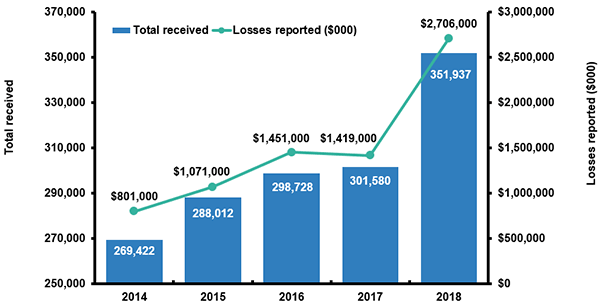 The scope of identity theft
The scope of identity theft
Identity theft continues to pose challenges for consumers as criminals develop new mechanisms to commit fraud. According to the 2019 Identity Fraud Study from Javelin Strategy & Research, the number of consumers who were victims of identity fraud fell to 14.4 million in 2018, down from a record high of 16.7 million in 2017. However, identity fraud victims in 2018 bore a heavier financial burden: 3.3 million people were responsible for some of the liability of the fraud committed against them, nearly three times as many as in 2016. Moreover, these victims’ out-of-pocket fraud costs more than doubled from 2016 to 2018 to $1.7 billion. New account fraud losses also rose slightly, with criminals beginning to focus their attention on different financial accounts, such as loyalty and rewards programs and retirement accounts. Additionally, criminals are becoming adept at foiling authentication processes, particularly mobile phone account takeovers. These takeovers nearly doubled to 680,000 victims in 2018, compared with 380,000 in 2017. The study does note that the shift to embedded chip cards is helping to contain existing card fraud, which showed the steepest decline of any fraud type in 2018, with losses at $14.7 billion in 2018, down from $16.8 billion in 2017.
Identity theft and fraud complaints
The Consumer Sentinel Network, maintained by the Federal Trade Commission (FTC), tracks consumer fraud and identity theft complaints that have been filed with federal, state and local law enforcement agencies and private organizations. Of the 3 million identity theft and fraud reports received in 2018, 1.4 million were fraud-related, and 25 percent of those cases reported money was lost. In 2018, consumers reported losing about $1.48 billion related to fraud complaints, an increase of $406 million from 2017. The median amount consumers paid in these cases was $375. Within the fraud category, imposter scams were the most reported and ranked first among the top 10 fraud categories identified by the FTC. They accounted for $488 million in losses. In 2018, 15 percent of all complaints were related to identity theft. Identity theft complaints were the third most reported to the FTC. Identity theft claims fell from 2015 to 2018 by 9.3 percent, but began to increase again in 2018 and were up 19.8 percent from 2017 to 2018.
Identity Theft And Fraud Reports, 2015-2018 (1)

(1) Percentages are based on the total number of Consumer Sentinel Network reports by calendar year. These figures exclude “Do Not Call” registry complaints.
Source: Federal Trade Commission, Consumer Sentinel Network.
|
(1) Consumers can report multiple types of identity theft. In 2018, 17 percent of identity theft reports included more than one type of identity theft.
(2) Includes online shopping and payment account fraud, email and social media fraud, and medical services, insurance and securities account fraud, and other identity theft.
Source: Federal Trade Commission, Consumer Sentinel Network.
Identity Theft By State, 2018 (1)
|
(1) Includes the District of Columbia and Puerto Rico.
(2) Population figures are based on the 2018 U.S. Census population estimates.
(3) Ranked by complaints per 100,000 population. States with the same number of complaints per 100,000 population receive the same rank.
Source: Federal Trade Commission, Consumer Sentinel Network.
See also the Identity Theft section of our Web site Click Here
Top 10 Writers Of Identity Theft Insurance By Direct Premiums Written, 2018 (1)
($000)
|
(1) Includes stand-alone policies and the identity theft portion of package policies. Does not include premiums from companies that cannot report premiums for identity theft coverage provided as part of package policies.
(2) Before reinsurance transactions.
(3) Includes only companies that can report premiums for stand-alone identity theft coverage and coverage provided as part of package policies.
Source: NAIC data, sourced from S&P Global Market Intelligence, Insurance Information Institute.
Cybercrime
As businesses increasingly depend on electronic data and computer networks to conduct their daily operations, growing pools of personal and financial information are being transferred and stored online. This can leave individuals exposed to privacy violations, and financial institutions and other businesses exposed to potentially enormous liability, if and when a data security breach occurs.
Interest in cyber insurance and cyberrisk continues to grow as a result of high-profile data breaches and awareness of the almost endless range of exposures businesses face. In 2019 the worst data breaches were the Capital One Financial Corp. breach in July that exposed 100 million records and the October Adobe Creative Cloud breach that exposed 7 million users. In 2017 the largest U.S. credit bureau, Equifax Inc., suffered a breach that exposed the personal data of 145 million people, including Social Security numbers. It was among the worst breaches on record because of the amount of sensitive information stolen.
In 2019, there were 1,473 breaches, up 17 percent from 1,257 in 2018 but below the record number of breaches in 2017, when there were 1,632 breaches. However, the number of sensitive (i.e., personal identifying information) records exposed in 2019 totaled 164.7 million, down 65 percent from 471.2 million in 2018, according to the Identity Theft Resource Center‘s 2019 End-of-Year Data Breach Report. The business sector again faced the highest number of breaches—644 in 2019 compared with 575 in 2018. The ITRC notes that while the business sector accounted for 44 percent of total 2019 breaches, these breaches exposed only 11 percent of all sensitive records. The medical/healthcare sector ranked second in 2019 for the number of breaches, with 525, exposing 39.4 million sensitive records. The education sector had 113 breaches, ranking third, with 2.3 million sensitive records exposed. Breaches in the banking/credit/financial sector—totaling 108—ranked fourth. However those breaches exposed 100.6 million or 61 percent of total sensitive records. The Capital One breach in July alone exposed 99 percent of the sensitive records in the banking sector.
In 2019 the ITRC reported that hacking was the most used method of breaching data, with 577 data breaches resulting in 15.3 million records exposed. This form of breach includes intrusion methods like phishing, ransomware and malware, and skimming. Unauthorized access ranked second with 538 data breaches, but this method affected the highest number of records exposed by data breach type—142 million, or 86 percent of all sensitive records exposed in 2019. Employee error or negligence, improper exposure or lost data had the third highest number of breaches, 161, with 2.9 million records exposed.
Despite conflicting analyses, the costs associated with cybercrime are increasing. McAfee and the Center for Strategic and International Studies (CSIS) estimated the likely annual cost to the global economy from cybercrime is $445 billion a year, with a range of between $375 billion and $575 billion. The average cost of a data breach globally was $13.0 million in 2018, up 12 percent from $11.7 million in 2017, according to a 2019 study from the Ponemon Institute and Accenture. Researchers polled 355 organizations located in 11 countries to determine what costs they faced after a cyberattack, such as the costs to detect, recover, investigate and manage the incident response. They also included the cost of activities that occur after the fact and efforts to reduce business interruption and loss of customers. In the United States, the average annual cost of cybercrime rose 29 percent in 2018, to $27.4 million, compared with $21.2 million in 2017. Globally, the banking industry had the highest average annual cost in 2018—$18.4 million—up from $16.7 million in 2017, followed by utilities and software companies. By type of attack, malware incidents had the highest cost, at $2.6 million followed closely by web-based attacks at $2.3 million.
Cyber insurance evolved as a product in the United States in the mid- to late-1990s as insurers have had to expand coverage for a risk that is rapidly shifting in scope and nature. In 2018, 545 insurers reported writing cyber insurance, up from 505 in 2017, according to NAIC data sourced from S&P Global Market Intelligence. Direct premiums written totaled $2.0 billion in 2018, from companies that can report premiums for stand-alone and coverage provided as part of package policies, up from $1.86 billion in 2017.
According to the Insurance Information Institute (I.I.I.) and J.D. Power 2019 Small Business Cyber Insurance and Security Spotlight SurveySM, 12 percent of businesses surveyed suffered one or more cyber incidents in the prior year, up from 10 percent in 2018. Nearly 71 percent said they are “very concerned” about cyber incidents, up from 58 percent in 2018, and 75 percent said they believe the risk of being victimized by a cyberattack is growing at an alarming rate–up from 70 percent in 2018. Among the 44 percent of respondents who said they do not currently have cyber insurance and the 21 percent who said they do not know whether they do, 64 percent said they do not plan to purchase a cyber insurance policy in the next 12 months. While this is down from 70 percent in 2018 and given small companies’ growing awareness and concerns about cyberrisk, insurers and agents and brokers might be able to increase their overall support of this market by addressing the issues of affordability and coverage limitations that seem to be an obstacle to purchasing.
Number Of Data Breaches And Records Exposed, 2009-2018 (1)

(1) As of January 7, 2019.
Source: Identity Theft Resource Center, 2018 End of Year Data Breach Report.
The Internet Crime Complaint Center (IC3), a joint project of the Federal Bureau of Investigation, the National White Collar Crime Center and the Bureau of Justice Assistance monitors Internet-related criminal complaints. In 2018 the IC3 received and processed 351,937 complaints, a 17 percent increase from 2017. Losses soared to $2.7 billion in 2018, almost double losses reported in 2017 that totaled $1.4 billion. In terms of dollar losses, business email compromise and email account compromise complaints were the most reported scams, with about $1.3 billion in losses, close to half of all losses. This type of scam targets both businesses and individuals who perform wire transfers. Criminals hack email accounts and attempt unauthorized fund transfers. About 20,000 people were victims of email account scams. Personal data breaches resulted in $149 million in losses and identity theft caused $100 million in losses. About 51,000 people were victims of personal data breaches and 16,000 were victims of identity theft scams.
Almost one out of four victims (24.1 percent) was over the age of 60. Close to half of all victims were under the age of 50, and they accounted for 57 percent of all losses in 2018.
Cybercrime Complaints, 2014-2018 (1)

(1) Based on complaints submitted to the Internet Crime Complaint Center.
Source: Internet Crime Complaint Center.
Top 10 States By Number Cybercrime Victims, 2018 (1)
|
(1) Based on the total number of complaints submitted to the Internet Crime Complaint Center via its website from each state and the District of Columbia where the complainant provided state information.
Source: Internet Crime Complaint Center.
Top 10 Writers Of Cybersecurity Insurance By Direct Premiums Written, 2018 (1)
($000)
|
(1) Includes stand-alone policies and the cybersecurity portion of package policies. Does not include premiums from companies that cannot report premiums for cybersecurity coverage provided as part of package policies.
(2) Before reinsurance transactions.
(3) Includes only companies that can report premiums for stand-alone cybersecurity coverage and coverage provided as part of package policies.
Source: NAIC data, sourced from S&P Global Market Intelligence, Insurance Information Institute.
Source: Insurance Information Institute, “Identify Theft and Cybercrime” http://www.iii.org/ website. Accessed February 11, 2020. http://www.iii.org/fact-statistic/identity-theft-and-cybercrime
© Copyright 2020. All rights reserved. This content is strictly for informational purposes and although experts have prepared it, the reader should not substitute this information for professional insurance advice. If you have any questions, please consult your insurance professional before acting on any information presented. Read more.
